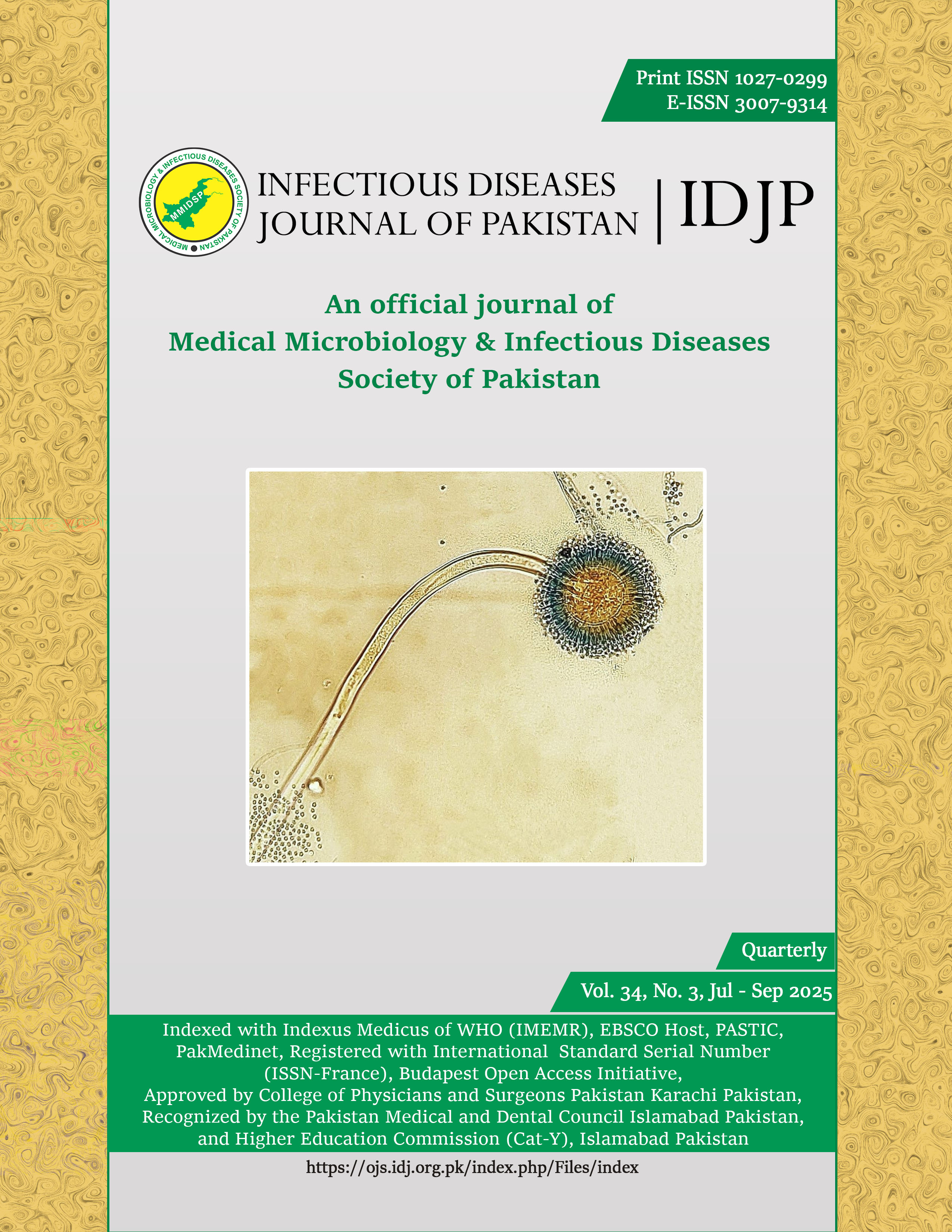Microbial profile and antibiotic resistance patterns of organisms causing venous catheter infections in hemodialysis units
DOI:
https://doi.org/10.61529/idjp.v34i3.441Abstract
Background: Central venous catheters (CVCs) are widely used in hemodialysis but predispose patients to catheter-related bloodstream infections (CRBSIs). This study evaluated microbial patterns, antibiotic resistance, and risk factors of CRBSIs in tunneled CVCs at a tertiary care hospital.
Material and Methods: Cross-sectional analytical study was conducted from January to June 2025 at hemodialysis unit of Bahawal Victoria Hospital, Bahawalpur. Total 340 adult patients with tunneled CVCs and clinical signs of CRBSI were enrolled. Confirmed CRBSI was defined by CDC/CLSI criteria using differential time to positivity or semi-quantitative catheter tip culture. Blood and catheter tip samples were processed for microbial identification and antimicrobial susceptibility testing. Data were analyzed using SPSS version 23.0.
Results: Only 32 patients (9.4%) had confirmed CRBSI. Gram-positive bacteria predominated (70.6%) with Staphylococcus aureus (38.2%) and coagulase-negative staphylococci (26.5%) as the leading pathogens. Gram-negative bacteria (23.5%) included Klebsiella pneumoniae and Pseudomonas aeruginosa. Fungal infections (5.9%) were due to Candida albicans. High resistance rates were observed: 61.5% of S. aureus were MRSA, 77.8% of CoNS were methicillin-resistant and 50.0% of Gram-negative isolates were ESBL producers. A catheter dwell time >6 months was significantly associated with CRBSI (p < 0.001).
Conclusion: Despite a low confirmed CRBSI rate the high prevalence of multidrug-resistant organisms among confirmed cases highlights critical need for accurate diagnosis and antimicrobial stewardship. Prolonged catheter use is a key modifiable risk factor.
Keywords: Candida albicans, Catheter-related bloodstream infection, Central venous catheter, Drug resistance, microbial, Pseudomonas aeruginosa, Staphylococcus aureus.
References
Lok CE, Huber TS, Lee T, Shenoy S, Yevzlin AS, Abreo K, et al. KDOQI clinical practice guideline for vascular access: 2019 update. Am J Kidney Dis. 2020; 75(4): S1-164. DOI: https://doi.org/10.1053/j.ajkd.2019.12.001
Agarwal AK, Haddad NJ, Vachharajani TJ, Asif A. Innovations in vascular access for hemodialysis. Kidney Int. 2019; 95(5): 1053-63. DOI: https://doi.org/10.1016/j.kint.2018.11.046
Hadian B, Zafarmohtashami A, Razani M. Catheter-related blood stream infections in hemodialysis patients. J Renal Inj Prev. 2020; 9 (4): e34. DOI: https://doi.org/10.34172/jrip.2020.34
Buetti N, Marschall J, Drees M, Fakih MG, Hadaway L, Maragakis LL, et al. Strategies to prevent central line-associated bloodstream infections in acute-care hospitals: 2022 Update. Infect Control Hosp Epidemiol. 2022; 43(5): 553-69. DOI: https://doi.org/10.1017/ice.2022.87
Kumbar L, Yee J. Current concepts in hemodialysis vascular access infections. Adv Chronic Kidney Dis. 2019; 26(1): 16-22. DOI: https://doi.org/10.1053/j.ackd.2018.10.005
Santos RP, Carvalho AR, Peres LA, Ronco C, Macedo E. An epidemiologic overview of acute kidney injury in intensive care units. Rev Assoc Med Bras. 2019; 65: 1094-101. DOI: https://doi.org/10.1590/1806-9282.65.8.1094
Teja B, Bosch NA, Diep C, Pereira TV, Mauricio P, Sklar MC, et al. Complication rates of central venous catheters: A systematic review and meta-analysis. JAMA Intern Med. 2024; 184(5): 474-82. DOI: https://doi.org/10.1001/jamainternmed.2023.8232
Han Y, Saran R. Global dialysis perspective: United States. Kidney 360. 2020; 1(10): 1137-42. DOI: https://doi.org/10.34067/KID.0001602020
Navidinia M, Mohammadi A, Arjmand R, Dadashi M, Goudarzi M. Molecular typing, biofilm formation, and analysis of adhesion factors in Staphylococcus aureus strains isolated from urinary tract infections. Gene Rep. 2021; 22: 101008. DOI: https://doi.org/10.1016/j.genrep.2020.101008
Guo H, Zhang L, He H, Wang L. Risk factors for catheter-associated bloodstream infection in hemodialysis patients: A meta-analysis. PLoS One. 2024; 19(3): e0299715. DOI: https://doi.org/10.1371/journal.pone.0299715
European Centre for Disease Prevention and Control. Antimicrobial Resistance in the EU/EEA (EARS-Net)—Annual Epidemiological Report 2022. Stockholm: ECDC: 2023. Available from: https://www.ecdc .europa.eu/en/publications-data/surveillance-antimicrobial-resistance-europe-2022
AbuTaha SA, Al-Kharraz T, Belkebir S, Abu Taha A, Zyoud SE. Patterns of microbial resistance in bloodstream infections of hemodialysis patients: a cross-sectional study from Palestine. Sci Rep. 2022 26;12(1):18003. DOI: https://doi.org/10.1038/s41598-022-21979-7
Xiao Z, Wang Q, Zhu F, An Y. Epidemiology, species distribution, antifungal susceptibility and mortality risk factors of candidemia among critically ill patients: a retrospective study from 2011 to 2017 in a teaching hospital in China. Antimicrob Resist Infect Control. 2019; 8(1):89. DOI: https://doi.org/10.1186/s13756-019-0534-2
Carmena MD, Farrero M, Peiro MT, Crespo M, Jiménez JD, Molina BD, et al. Management of kidney disease in heart transplant patients: A national Delphi survey-based consensus expert paper. Transplantation. 2025: 10-97. DOI: https://doi.org/10.1097/tp.0000000000005302
Hussain M, Khan MN, Rehman K, Mirza IA, Rehman M, Riaz S. Bacterial spectrum and antimicrobial pattern of blood stream infections associated with non-tunneled double lumen catheter in hemodialysis patients. Pak Armed Forces Med J. 2021; 71(4). DOI: https://doi.org/10.51253/pafmj.v71i4.4438
Bhatti JM, Raza SA, Alam AF, Khan YN, Mala A, Batool I, et al. Antibiotic choices among healthcare professionals for enterococcal bacteremia with patterns of resistance and risk factors of mortality, in settings of poor antibiotic stewardship program—a five-year retrospective cohort study. BMC Infect Dis. 2023; 23(1): 514. DOI: https://doi.org/10.1186/s12879-023-08498-0
Abd El-Hamid El-Kady R, Waggas D, AkL A. Microbial repercussion on hemodialysis catheter-related bloodstream infection outcome: A 2-year retrospective study. Infect Drug Resist. 2021: 4067-75. DOI: https://doi.org/10.2147/IDR.S333438
Kariyawasam RM, Julien DA, Jelinski DC, Larose SL, Rennert-May E, Conly JM, et al. Antimicrobial resistance (AMR) in COVID-19 patients: A systematic review and meta-analysis (November 2019–June 2021). Antimicrob Resist Infect Control. 2022; 11(1): 45. DOI: https://doi.org/10.1186/s13756-022-01085-z
Guo H, Zhang L, He H, Wang L. Risk factors for catheter-associated bloodstream infection in hemodialysis patients: A meta-analysis. PLoS One. 2024; 19(3): e0299715. https://doi.org/10.1371/journal.pone.0299715
Shrestha SK, Trotter A, Shrestha PK. Epidemiology and risk factors of Healthcare-Associated infections in critically ill patients in a Tertiary Care Teaching Hospital in Nepal: a prospective cohort study. Infectious Diseases: Res Treatment. 2022; 15: 11786337211071120. DOI: https://doi.org/10.1177/11786337211071120
Downloads
Published
How to Cite
Issue
Section
License
Copyright (c) 2025 Editor Office

This work is licensed under a Creative Commons Attribution-NonCommercial 4.0 International License.



